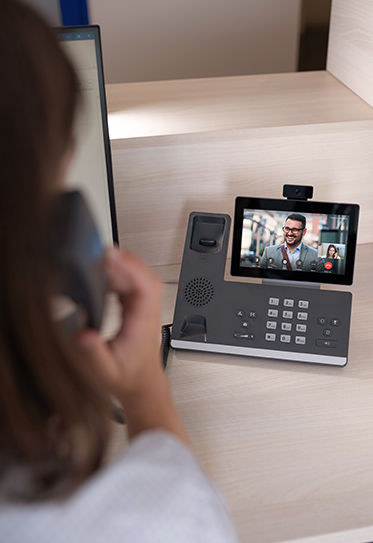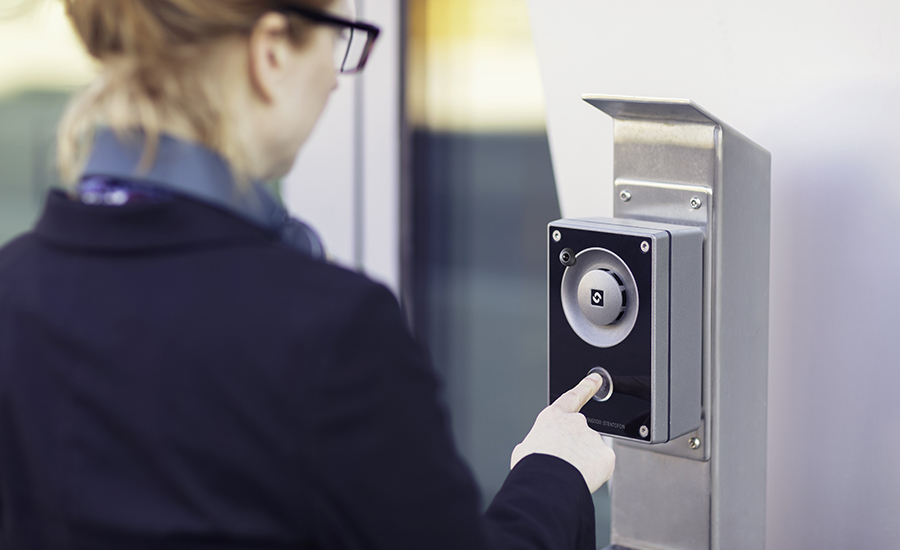
QR Codes can be generated for visitors seeking temporary access. // IMAGE COURTESY OF AXIS COMMUNICATIONS
What’s Trending in Intercoms & Entry Control Systems?
Industry experts weigh in on the technological progress that’s shaping the intercom and entry control market.
The entry control market is a subset of the larger access control space, distinct in that it typically addresses clearance for non-employee, temporary visitors or others who don’t have an electronic access control credential. “An entry control system … allows entry to an individual, whether they may be vetted in advance to be there, or whether they simply show up at a door and ask for entrance,” says Bruce Czerwinski, vice president of sales and business development, safety and security, Zenitel Americas, Kansas City, Mo.
Typically, entry control solutions utilize intercoms for security or other authorized personnel to communicate with individuals seeking entrance. “The main purpose of intercoms is communication — commonly between a person outside of a building to a person inside a building or at an emergency call station, such as on a campus or in a parking garage,” says Dom Albano, program manager, intercoms, Axis Communications, Chelmsford, Mass.
However, entry control solutions can encompass more, Albano says. “Generally, this type of solution is a system tied to a door lock or gate. The system could be an intercom tied to a door lock release that allows the recipient of the call to ‘buzz’ people in. Or it could be an access control system that allows you to enter user credentials (e.g., RFID card or pin code) to release the door. It could also be an all-in-one system where access control technology is built into an intercom. These types of solutions can be used anywhere you need to control the entry of individuals.”

The audio component of an intercom system is one aspect that can be underestimated by dealers and integrators, according to Czerwinski. “Often, dealers and integrators may not include audio into a security solution at the initial design, but that needs to be done in order to avoid selling and installing an incomplete solution that does not meet all communications and security and safety needs,” he says. “Relying entirely on video, access control and other surveillance technologies to mitigate threats is a missed opportunity to help security teams to understand the whole situation and respond effectively. Dealers and integrators should always sell intercom and audio solutions as part of their solutions as the customer is looking to them as security experts.”
Czerwinski continues, “Once the decision has been made to add an audio solution, the question has to be asked: What does the customer want to happen when the button on the intercom is pushed? What security risks do they want audio solutions via intercoms to help mitigate? Having that knowledge will help a dealer or integrator to understand what additional solutions or products in addition to the intercoms may be needed to solve the customer’s pain points.”
Latest Tech Developments
Entry control has developed beyond just buzzing people in to encompass mobile credentials, video analytics, two-way video and cloud offerings.
“With entry control, the biggest development has been with mobile credentials and the ability to have temporary and mobile credentials sent to your phone so that you can enter a premise without any physical card,” says Brad Kamcheff, marketing manager, Aiphone Corp. Redmond, Wash.
Albano adds, “The first thing that comes to mind is two-way video calling — which is becoming more prevalent. Another development is the introduction of more interactive options, such as direct or remote access control from a cell phone and the inclusion of built-in audio and video analytics.
“Other developments include ‘talking entry control solutions’ — sensors that activate audio warnings or recordings based on predetermined triggers. And new types of user credentials are being implemented such as license plate verification for gate entry, and Bluetooth and QR codes access control,” Albano continues. “We are also seeing more cloud offerings. From answering intercom calls remotely to managing full systems, cloud offers increased convenience and accessibility of systems that benefits both end users and integrators.”
Post-Pandemic Positives

The COVID-19 pandemic led to technological advancements that continue to benefit the entry control market. Bruce Czerwinski, Zenitel Americas, says, “We increasingly see intercom solutions being installed and used for contactless access with entry and exit, as there continues to be a need to interact and communicate with individuals moving in and out of doors and spaces without physical intervention. Intelligent communications, integrated with contactless access control, can help a business to comply with pandemic safety guidelines.”
In the healthcare space, particularly, Czerwinski says, “COVID-19 has also increased the need for clean-room isolation and quarantine spaces, in areas not originally intended for that use, where risk of infection is high, and equipment must be regularly disinfected. Here, purpose-built clean room intercoms, providing clear touchless communications, have emerged as critical tools for enabling patient care while reducing the need to enter the contaminated space. For example, voice communication can enable hospital staff to verify identity and to communicate with patients without entering the infectious environment, which can reduce the amount of exposure to the virus. In non-emergency healthcare facilities, such as medical centers, voice can effectively relay information to building occupants and visitors for screening. For example, a patient who seeks access to a medical center for an appointment can hear important instructions from a nurse via the intercom solution.”
Technological advancements are being made every day in every sector of the security industry, and Bobby Welliver, assistant vice president of multifamily housing solutions at dormakaba, Indianapolis, has some cautionary advice for entry control providers. “The two biggest mistakes by far are not understanding the complete needs of the customer and not accounting for technology upgrades that may occur during construction. It’s ideal to have a discussion that includes integrators, property owners and suppliers. … A lot of building technology can change between the time a building is designed on paper and when it is constructed.”
Welliver continues, “In addition to the initial conversations, it’s important to identify a check-in period in the statement of work (SOW) that allows all parties to review technology updates both in market and to the building plan. The construction period is the time to make sure the technology is as future-proofed as possible. Once a property opens, it can be very expensive and disruptive for residents to accommodate technology advances if not planned accordingly.”
Move to IP Solutions
Another development in both the intercom and the entry control market has been the move to IP solutions. According Kamcheff, “In the intercom space, there have not been a lot of groundbreaking innovations.” But, he says, “For us, it’s the adoption of IP video and the ability to integrate with other systems. Intercoms can’t stand alone anymore and these systems need to be part of the bigger puzzle pieces.”
“Dealers and integrators need to know — and communicate to end users — that there is most likely a migration path for them that will make the transition to IP much easier.” — Bruce Czerwinski, Zenitel Americas
Speaking of the entry control market, James Catt, product specialist, Viking Electronics, Hudson, Wis., says, “Entry control technology is constantly changing and evolving. These days, IP is the preferred platform to use for your entry system, as it ties into a VoIP phone system very easily.”
According to Czerwinski, “An IP intercom solution allows audio conversations and interaction between the person outside the door and inside the door, namely a security guard who controls ID card access at the door. More than ever, we see the security industry fast-tracking the move to IP solutions, which provide a wealth of additional features and capabilities never seen before.
“As legacy manufacturing components become scarce, the manufacturing and support of analog technology solutions becomes more difficult. Dealers and integrators need to know — and communicate to end users — that there is most likely a migration path for them that will make the transition to IP much easier.”
New on the Entry Control Market
Reliability & Scalability
Like his advice to consider “future-proofing” solutions, Welliver also offers insight into the importance of scalability. “The common goal is to deliver a property-wide solution successfully for every property, using a fob, phone or pin code that can be delivered through one graphic user interface. ... Buildings need access solutions that can scale up or down as needed. These can be complex in nature depending on the overall need of the total system.”
Kamcheff agrees: “Systems are rapidly expanding beyond their stated capacity so that integrators need to be mindful that the printed information about the system may be outdated on the limitations. … Don’t forget to talk about expansion, even if they aren’t going to buy it today so you can make sure that when they do get funding to expand, the existing system is capable of handling that and you don’t have to rip out the entire system.”

“The latest and greatest entry control systems installed today could be outdated tomorrow. It is best to use products that are battle tested and built to last. Depend on reliable technology, not the latest fad.” — James Catt, Viking Electronics Inc.
But consistently, the most important quality in the opinion of these industry experts is reliability. “Yes, security professionals continue to have a high duty of care, in addition to the always present demand for return on investment (ROI) on the security solutions that they employ,” Czerwinski says. “For dealers and integrators, that means that the security solutions that they select and install must be more reliable than ever. With intercoms and entry control solutions, it means not accepting poor audio or video quality, but instead, seeking solutions that provide powerful and proven audio technology and HD video, along with a touchless application, and that work in every situation.”
Echoing that sentiment, Albano says, “Supportability is essential. When manufacturers provide solutions that offer reliability along with ease of installation, maintenance and use — backed by quality technical support and a solid warranty — dealers, integrators and end users all benefit.”
Put bluntly, Catt says, “The latest and greatest entry control systems installed today could be outdated tomorrow. It is best to use products that are battle tested and built to last. Depend on reliable technology, not the latest fad.”




